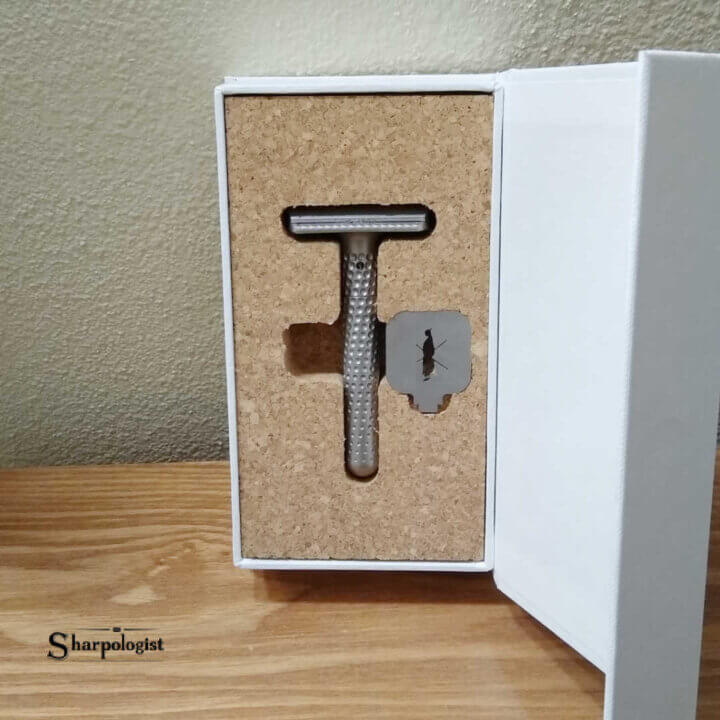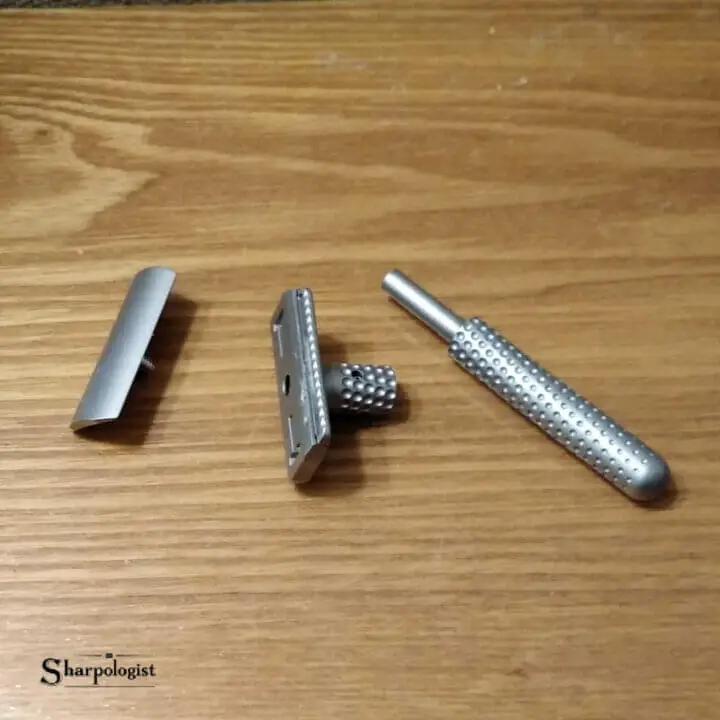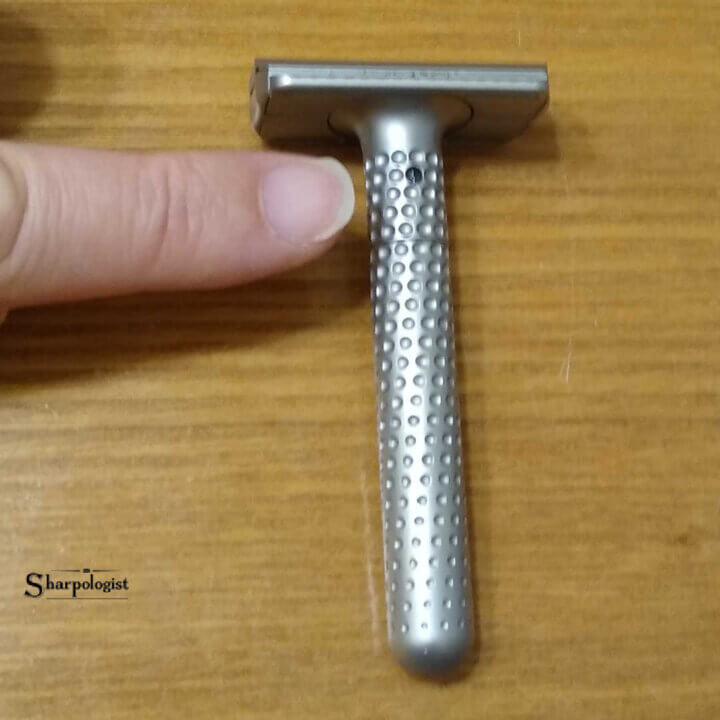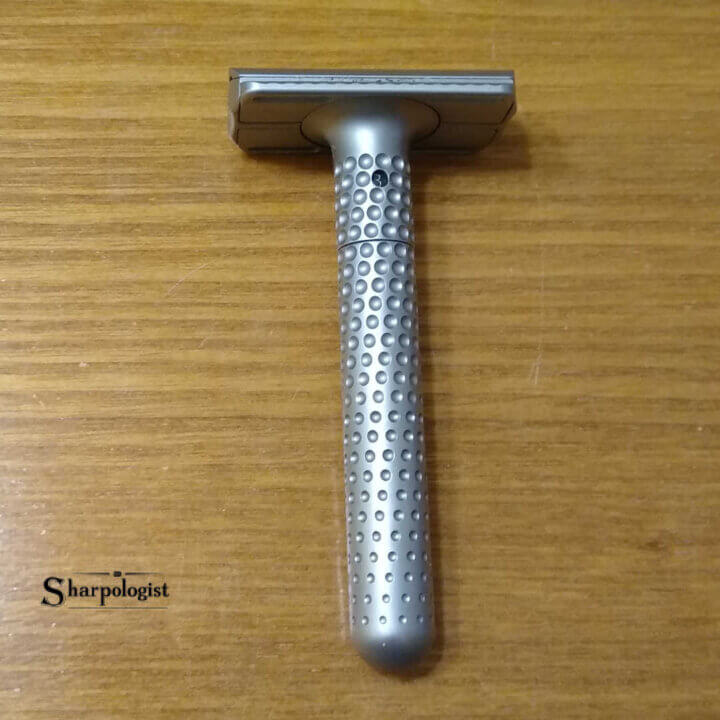
When I read about the new Tatara Muramasa adjustable double edge razor and the design technology behind it I was intrigued. But I admit I paused with a little “sticker shock” before I dropped US $400 on the razor. Is it worth the price?
Piqued Interest
It’s no secret that I’m a big fan of adjustable razors. I’m also not (too) afraid to “take one for the team” when an expensive razor comes along: I have the Oneblade Genesis, the GilletteLabs/Art Of Shaving Heated Razor, and the Rex Ambassador adjustable razor, for example.
The Tatara Muramasa adjustable razor adjusts in an unusual way, sliding the base skin guard in-and-out instead of the up-and-down movement of more conventional adjustable razors. It’s a little like the way the Parker Adjustable Injector works, only in a double edge configuration.
My interest was piqued.
As the first few reviews of the Tatara Muramasa adjustable razor dribbled in (summarized in a later section) I was a little concerned with some of the negative comments about certain elements of the design. But I had such a positive experience with the Tatara Masamune razor that I was prepared to take a “leap of faith” with the Muramasa despite the price.
Tatara Muramasa Website And Specs
From the Tatara website:
The Muramasa is a highly efficient and comfortable adjustable safety razor that allows shavers to choose the preferred shave setting (smooth or aggressive) by simply turning the razor dial.
Due to its fine-tuning adjustable mechanism and superior construction quality, it provides an adaptable shave. Perfect for both wet shaving beginners and experts…..
How It Works
The Muramasa razor is comprised of an adjustable sliding base-plates system that provides a strong support to the blade and a quick adjustment of the blade exposure (BE) and blade gap (BG).
While rotating the dial you will move the base plates together/apart from the razor’s head, changing the point of contact between the blade and the user’s skin.
This means a difference in BG and BE at the same time.
A numbered window will display the level setting you are at as you rotate the dial….

Design
The design of the Muramasa was thought as a unified entity and not as a raw mechanical assembly of different parts.
The handle is designed using a twisted dimple pattern that enlarges towards the head of the razor for a better grip while displaying the concept of an adjustable razor.
The compact design was developed to avoid blade chatter and blade rattle to ensure a safe and efficient performance in every setting….
Every Piece Is Hand Finished
All the 7 pieces in the Muramasa are hand finished and sandblasted – piece by piece.
Through this process, we achieve a smoother gunmetal matte look, softened edges, and we eliminate CNC machining markings.
The numbered piece on the Muramasa dial is inspired by the analog watch date window and is coated with dark PVD to allow a better glance at the number setting….
Weight: 105 gr / Dim. 88,2x44x25 mm / Handle: Ø11.7×59,6 mm
What Others Are Saying About The Tatara Muramasa Adjustable Razor
There are not too many reviews out yet but of those that are, these seem to be the primary pro’s and con’s:
Pro’s
- Virtually all posts and comments about the Tatara Muramasa adjustable razor remark how good the build quality is.
- Related, many mention the razor’s “heft” (but not too heavy) and balance. The grip from the dimpled handle and the handle’s length work well together: it feels good in the hand.
- Most remark that the razor is easy to use. The “sweet spot” for razor angle, the razor’s “adjustability,” and the relatively thin head design make the process of shaving an easy one, even for relative beginners.
Con’s
- The adjustment-setting window is too small.
- The razor has a three piece design with a “non-standard” handle threading scheme: you will not be able to make a “Frankenrazor” with the Tatara Muramasa.
- Price (“Uff da“)
My Experience With The Tatara Muramasa Adjustable Razor
So what do I think about the Tatara Muramasa adjustable razor? Is it a Shogun, a leader of Samurai warriors; or a Ronin, a renegade Samurai without a master to fight for? Or something in between?
Presentation, Design, And Construction
Like other Tatara razors, the Tatara Muramasa adjustable razor comes in a cork-lined presentation box. A disassembly “key” is included to help with taking the adjustment mechanics apart for cleaning should it become necessary.
As other reviewers have mentioned, the adjustment dial window is very small–teeny-tiny–and difficult for me to read. However it is continuously adjustable, without any click-stops:

Initially, adjusting to a milder setting probably wasn’t be much of a problem for me, but adjusting to a more aggressive shave may require an awkward grasp: one hand holds the razors head (over the blade’s tab covers) while the other adjusts the dial. Holding the razor by the handle to adjust upward will simply unscrew the handle from the head otherwise.
I reached out to Tatara (on Instagram) to ask if they were planning to enlarge the dial number window or change the way the dial works in the next version. Their response:
We are always considering improving our products base on the feedback that we have. We had long discussions with the designers to enlarge the window, however that would “damage” the design concept and will create sharp edges once we enter in the dimples edge next to the window.
Using a different process for the number or maybe apply some color ink to them could be a solution for the future yes 🙂
Regarding the dial. For a sliding base plates system we will always need a piece to rotate and force the plates to go in and out. The turning force is something that we might study even deeper to allow a best fit because at the end it’s a compromise between if the slide plates are tight in order to don’t move during the shave (we took that point very seriously) or the Dial having a bit more gap between the parts and allow a easier rotation.
A short time later I received a small “O-Ring” with instructions on how to install it in the razor. Dialing up/down is no longer a problem. The new “O-Ring” is built into new Muramasa razors.
I think the adjustment “window” of the Tatara Muramasa to be biased slightly to the mild end of the range compared to other adjustable razors. Nothing dramatic, mind you, but if you’re the type that likes to turn an adjustable razor up to “11” this razor might disappoint. However for the vast majority of shavers I think the adjustment range is fine.
The handle texturing continues the distinctive “golf ball dimples” design that distinguish Tatara razors from others. It may look like it wouldn’t provide a decent grasp but I find it works quite well.
As other reviewers have mentioned I think the fit-and-finish is outstanding.
The Shave Itself

I think the adjustment engineering, with the base sliding in-and-out vs. up-and-down does seem to give a the razor a different feel on my skin. Not “better” or “worse” but “different.” I guess I will have to use it longer to give it a more quantifiable description.
Despite the razor’s design quirks, I’m getting great shaves from the Tatara Muramasa adjustable razor! I find it behaves very much like the Tatara Masasume I have (and that has become part of my regular razor rotation)–smooth and forgiving–but with the added ability to adjust the shave if I desire. I use this razor a bit differently from the other continuously adjustable razors I have: I found the ‘best’ setting for my typical shave (a bit over “2” on the dial. I generally prefer mild razors) than “set it and forget it.” Much like finding the best base plate for a razor that offers multiple plates (like Rockwell or Karve).
Conclusion
The Tatara Muramasa adjustable razor represents some really interesting design and engineering aspects. And I’m getting terrific shaves from it.
But I just can’t give it a full-throated endorsement due to its price and ergonomic quirks.
You can get a very similar shave by looking at the adjustment specs of the Muramasa and choosing another Tatara razor with similar blade exposure settings.

I started out with a Tatara Masamune razor, including both the base plates. When the Muramasa came out, I thought I’d add some flexibility to my set-up, but what I did was buy a Nodachi plate (solid bar), and not just to save money. It’s that I can increase blade gap without going ultra-positive in blade exposure.
With my Masamune cap, the Nodachi plate gives a 0.90mm blade gap but keeps the blade at -0.03mm. To get the same blade gap on the Muramasa, I’d need to deal with a +0.17mm blade exposure. It’s the negative exposure that drew me to Tatara in the first place, and my hybrid set-up suits me well. But if I ever DID want a plus-exposure Tatara, I could buy a Nodachi cap. In fact that would give me more flexibility from the other end because the large blade exposure remains steadier over a wider range of gaps than the Muramasa’s does. Same difference.
It wouldn’t surprise me if Tatara’s designers had tried to design an adjustable that let you adjust the two parameters separately. For one thing, look what they DID achieve. Who even thought this far before them? But, secondly, independent variability is precisely what their interchangeable cap-and-plate system ALREADY lets you do! It kind of sets the standard.
I’d never appreciated what their cap-and-plate system accomplished. It’s a little like what Joni Mitchell said: You don’t know what you’ve got till it’s gone. Only it’s not gone. It’s in the existing system. I think it deserves a belated tribute.
Comments are closed.